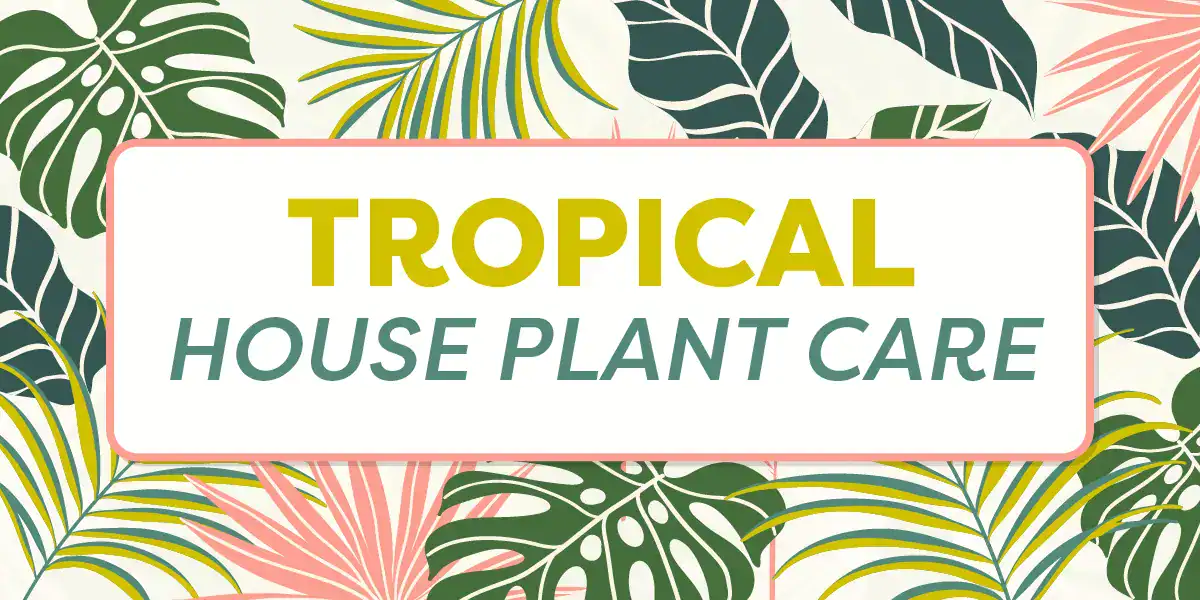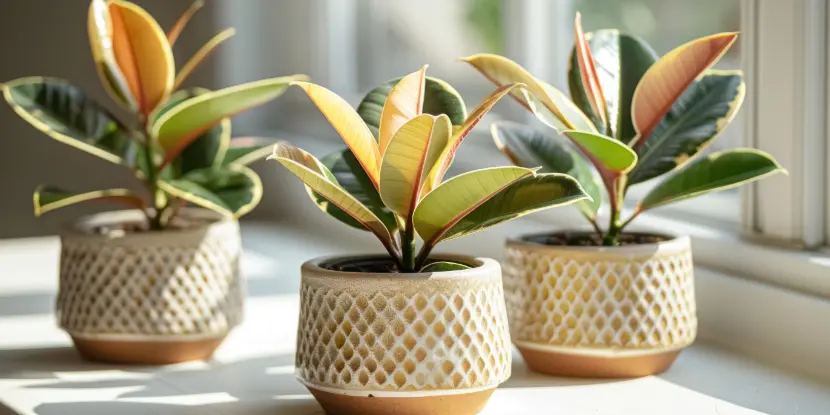Tropical plants soften an indoor environment. They’re like living, decorative furniture that amplifies an area’s comfort quotient.
Most tropical plants do perfectly fine indoors and will even take some abuse. If properly cared for, they’ll live to a ripe old age.
- Snake plants can thrive for decades with minimal care.
- Philodendron can live for many years indoors.
- Rubber trees last for decades in the right conditions.
- Jade plant has a very long lifespan, often several decades.
Here, we’ll discuss their general care and maintenance. With patience and dedication, even a beginning gardener can learn the tricks of the trade.
Light Conditions
Plants need light for photosynthesis, the process of food production. Carbon dioxide (CO2) from the air and water from the soil combine into glucose or simple sugar.
Too much light can be a problem, though, especially for tropical plants whose natural habitat is a tropical rainforest where light filters through the canopy of large trees.
To recreate this environment, sunlight filtered by 50% to 80% is ideal. For example, if direct sunlight enters a window, a sheer curtain will provide a light filter for tropical plants nearby. Where plant directions specify high, medium, or low light, this instruction applies to 50% filtered light duration.
Using Grow Lights
When natural light is lacking, grow lights can help.
- Select grow lights that match the needs of your tropical plants. LED grow lights are energy-efficient and produce the correct light spectrum for plant growth.
- Place the grow light about 12 to 18 inches away from the tops of the plants. Adjust the height as the plants grow to maintain the proper distance.
- Most tropical plants require about 12–16 hours of light daily. Use a timer to ensure consistent lighting and to mimic the natural day-night cycle.
- Observe how your plants respond to the grow light. If they show signs of light stress, such as browning tips or bleached leaves, reduce the light intensity or duration.
- Adjust the duration of light exposure depending on the season. When natural daylight is scarce in winter, plants might need additional hours under the grow lights.
Temperature
- The ideal temperature for most tropical plants is 72°F.
- Plants can survive temperatures ranging from 50° to 100°F.
- Avoid drastic or sudden changes in light and temperature to prevent plant shock.
- An example of a drastic change: increasing light exposure from 4 hours to 8 hours or a sudden 15° to 25° temperature change.
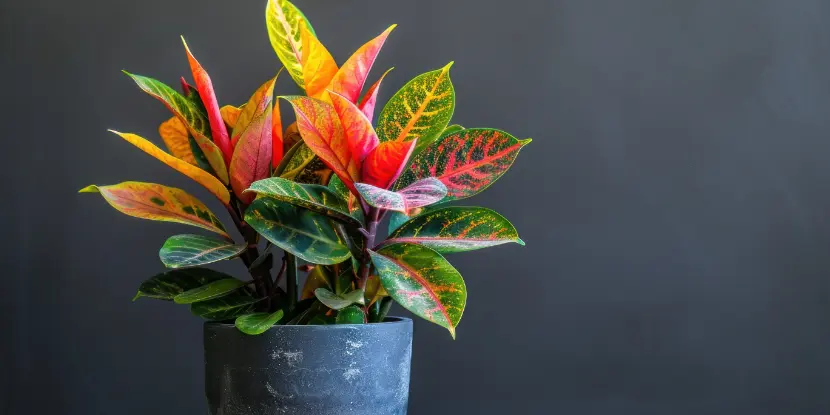
The brilliant variegated foliage of a croton plant.
When relocating a plant:
- Seek a similar environment.
- Make changes gradually over three weeks.
- Don’t place an indoor plant in the direct flow of an air conditioning or heating duct.
- Make changes early in the spring: This allows natural changes to occur as light and heat intensify with the progressing season.
Humidity
Most modern American homes and apartments have central air and heat. These units keep the humidity at about 30%. Most tropical plants do best with humidity of 80% to 100%, as in the rainforest. You can add humidity by:
- Spraying foliage daily with a mister.
- Place the plant on a tray or saucer containing one inch of gravel with water. This allows the water to sit below the pot and evaporate.
Plants shouldn’t sit directly in water. Placing charcoal in the tray will help keep things smelling fresh. Clean the tray once a month to discourage fungus or disease.
Soil & Fertilizers
Use commercially prepared potting soils to repot plants or to replace missing soil.
Premium soil mix is ideal for most houseplants growing outdoors in containers.
In the summer growing season, fertilize every 3 to 4 weeks with a water-soluble houseplant food, such as 20-20-20 or fish emulsion. In the winter months, every 2 months is sufficient. Follow the manufacturer’s dilution rates.
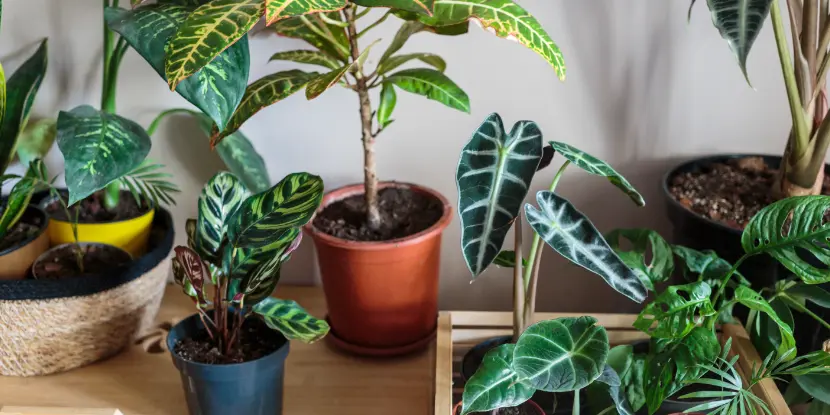
A collection of potted tropical plants on a tabletop.
Soil Preparation & Repotting
- Use a high-quality, commercially prepared potting mix for indoor plants. These mixes often contain materials like peat moss, vermiculite, and perlite that provide good aeration and drainage.
- Before repotting, sterilize your plant containers by washing them with a mild bleach solution (1 part bleach to 9 parts water) to prevent the spread of diseases.
- Ensure your pot has adequate drainage holes. Place a layer of small stones or gravel at the bottom of the pot to improve drainage.
- Fill the pot with the prepared potting mix, leaving enough space for the plant’s root ball.
- Gently remove the plant from its current container, loosen the root ball, and position it in the new pot. Fill in around the roots with the remaining potting mix.
Fertilizing
- Use a balanced, water-soluble houseplant fertilizer, such as a 20-20-20 formula containing equal parts nitrogen, phosphorus, and potassium.
- Follow the manufacturer’s instructions for dilution rates to avoid over-fertilizing, which can damage the plant roots.
- Fertilize every 3 to 4 weeks when plants are actively growing.
- Reduce fertilizing to every 2 months when plants are dormant.
- Water the plants thoroughly before applying the diluted fertilizer solution. Pour the fertilizer solution evenly over the soil, avoiding contact with the foliage.
Leaching & Watering
Leaching is a process for washing away accumulated fertilizer salts. Where excessive salt build-up exists, a white substance will appear on the pot or surface of the soil mixture.
- Run water through the soil to dissolve the salts and let them drain away.
- Wait 15 to 20 minutes and flood once more to remove the salts.
Watering plants is an art. Plant care novices often believe a good soaking is a cure-all for plant ailments.
- But one way to test soil moisture is to stick a finger 1 1/2 inches to 2 inches deep. If the soil feels dry, the plant is thirsty.
- Water until the soil is evenly moist, not saturated.
- If in doubt, let the plant dry out instead of watering more. Wilting is less harmful than rot caused by overwatering.
- Rain or distilled water is best for watering indoor plants, though not compulsory.
- If possible, let tap water stand for 24 hours to attain room temperature and release harmful gases.
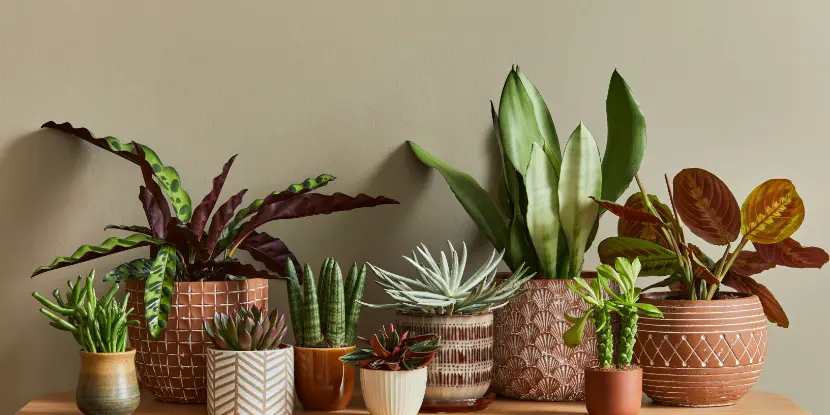
A collection of snake plants, tropical succulents, and more.
Containers
A container can be plastic, metal, clay, or ceramic. There’s no unique benefit to using one pot type over another but avoid aluminum and copper. Excessive copper can be toxic to plants, while aluminum can affect soil pH, making it more acidic.
Aluminum and Soil pH: Aluminum can affect the pH of the soil, potentially making it more acidic. This change in pH can impact nutrient availability and overall plant health. Therefore,
Some plants, such as cacti and succulents, do well in clay containers because the soil dries out faster than in plastic containers.
- Plastic pots retain moisture better than clay and dry out slower.
- Terra-cotta clay pots breathe easier and remove excess moisture from the soil.
- You can improve a pot’s ability to drain by adding perlite or peat moss during repotting.
Repotting Tropical Plants
Root bound plants should be repotted. Root-bound conditions exist when roots protrude from drainage holes or when roots are packed tight with very little soil upon removing the plant from the pot.
- The best time to repot tropical plants is during their active growing season, typically in the spring or early summer.
- Select a pot that is 1–2 inches larger in diameter than the current pot. Ensure it has adequate drainage holes.
- Use a high-quality, well-draining potting mix appropriate for tropical plants. A blend containing peat moss, coconut coir, and perlite works well.
- Carefully tip the plant out of its current pot. Tap the sides and bottom of the pot if needed to loosen the root ball.
- Inspect the roots for any signs of rot or disease. Trim away dead or damaged roots with sterilized scissors.
- Gently tease apart the root ball to stimulate new root growth. You can use your fingers or a small tool to do this.
- Position the plant in the center of the new pot. The top of the root ball should be about an inch below the pot’s rim.
- Fill around the plant with the prepared potting mix, firming it gently with your fingers and leaving no air pockets.
- Water the plant thoroughly to help settle the soil and eliminate any remaining air pockets.
- Watch for signs of stress or shock in the plant. Maintain consistent moisture levels, and avoid fertilizing for the first month after repotting to give the plant time to adjust.
Insect Control
Spider mites, mealybugs, aphids, and scale insects are the most common pests affecting tropical foliage plants. If you suspect insect problems, bring a sample to your Anawalt Garden Center for proper identification or use an app like PlantSnap.
- To prevent the infestation from spreading, move the affected plant away from other plants.
- Remove and dispose of heavily infested leaves or stems. This can significantly reduce the pest population.
- Use a strong stream of water to wash off insects from the plant. Be sure to target the underside of leaves and stems, where pests often hide.
- Spray the plant with insecticidal soap. Follow the product’s instructions.
- Neem oil is a natural insecticide. Mix it according to the product’s instructions and spray on affected areas.
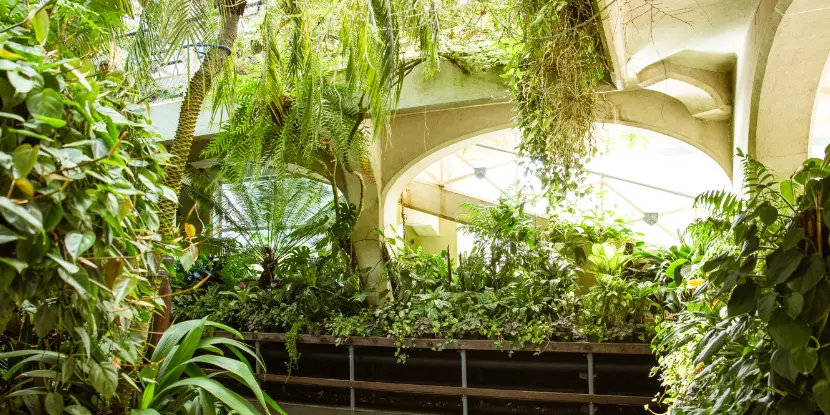
A greenhouse full of tropical plants.
Disease Control
Some signs of plant diseases are:
- Abnormally growing roots, stems, and other parts of the plant.
- Yellowing leaves, unusual leaf spots, loss of leaves.
- Drooping plants, even after watering.
Treating Diseases
- Isolate the affected plant to prevent the disease from spreading to healthy plants. Quarantining the plant can limit the spread of pathogens.
- Remove and discard any diseased parts of the plant. This may involve cutting off infected leaves, stems, or roots. Use sterilized pruning tools to avoid spreading the disease.
- Apply appropriate treatments based on the identified disease. Fungicides can be effective for fungal infections, while bacterial diseases may demand a more targeted approach.
- Ensure proper air circulation, avoid overwatering, and maintain optimal humidity levels. This can mitigate the proliferation of pathogens.
FAQs: Caring for Tropical Plants
Q: How often should I water my indoor tropical plants?
The watering frequency depends on the type of tropical plant and its environment. Generally, most tropical plants prefer their soil to be slightly moist but not soggy. A good rule of thumb is to water once the top inch of soil feels dry to the touch.
Q: What’s the best way to ensure my tropical plants get enough humidity?
You can increase humidity by misting the leaves regularly, placing a humidifier nearby, or keeping the plants in a well-lit, humid bathroom.
Q: Are there specific fertilizers I should use for my tropical houseplants?
Tropical plants benefit from nitrogen, phosphorus, and potassium fertilizers. Opt for a balanced, water-soluble fertilizer, and follow the application instructions. Over-fertilizing can harm your plants, so using the correct amount is critical.
Q: How much light do indoor tropical plants need?
Light requirements vary widely among tropical plants; however, most prefer bright, indirect sunlight. A good option is to place your plants near a window that gets abundant light but is shielded from direct rays by a sheer curtain.
Q: Can indoor tropical plants be prone to pests, and how can I manage them?
Indoor tropical plants can attract pests like spider mites, aphids, and mealybugs. Regularly inspecting your plants and wiping their leaves with a damp cloth can help prevent infestations. If you see pests, use an insecticidal soap or neem oil as a treatment.
Q: How important is the type of soil for indoor tropical plants?
The soil type is crucial for indoor tropical plants. We recommend a well-draining, peat-based potting mix that helps prevent waterlogging, which can lead to root rot.
Q: How can I tell if my indoor tropical plant isn’t doing well?
Signs that your tropical plant may not be thriving include yellowing leaves, stunted growth, dropping leaves, or visible pests on the plant. These symptoms can result from overwatering, under-fertilizing, or insufficient light.

